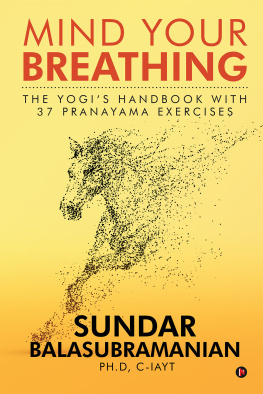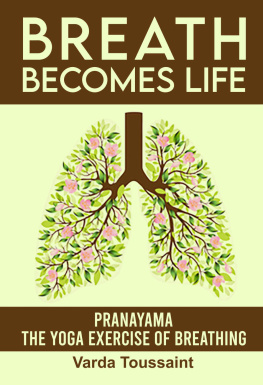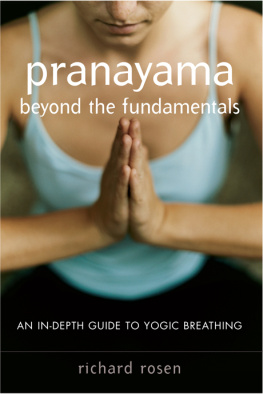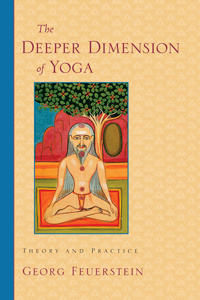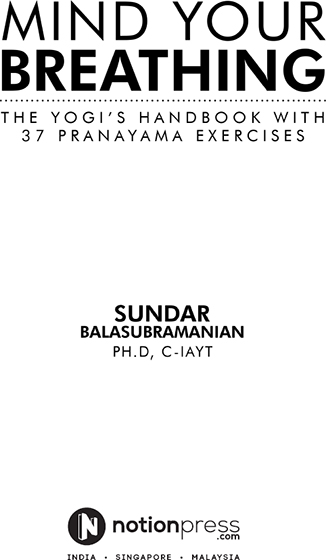

Notion Press
Old No. 38, New No. 6
McNichols Road, Chetpet
Chennai - 600 031
First Published by Notion Press 2019
Copyright Sundar Balasubramanian 2019
All Rights Reserved.
eISBN 978-1-68466-843-4
This book has been published with all efforts taken to make the material error-free after the consent of the author. However, the author and the publisher do not assume and hereby disclaim any liability to any party for any loss, damage, or disruption caused by errors or omissions, whether such errors or omissions result from negligence, accident, or any other cause.
While every effort has been made to avoid any mistake or omission, this publication is being sold on the condition and understanding that neither the author nor the publishers or printers would be liable in any manner to any person by reason of any mistake or omission in this publication or for any action taken or omitted to be taken or advice rendered or accepted on the basis of this work. For any defect in printing or binding the publishers will be liable only to replace the defective copy by another copy of this work then available.
Dedicated to
THE ONENESS
Foreword
Having been a medical researcher for many years, it is always a joy to meet a colleague in the field. Sundar and I met in 2013 at Yogaville, VA when he attended Yoga of the Heart (a certification to adapt the sacred practices of Yoga for students with cardiac disease and cancer). Meeting him, I had a more complete feeling than what I often experience with other researchers. At the time, I attributed it to the fact that Sundar has been doing research in the rarefied field of Yogic practices for the past several years, while having academic roots from a traditional learning background. He shares what his research has yielded about the subtlety of Pranayama practices for patients well being, and education.
I felt an immediate sense of kindness and a desire to share the data that he formulated. He seemed incapable of exaggerating the findings to make himself seem important; rather, he wanted to make it available to enhance other peoples lives. Because his research involves ancient practices rather than a pill or gadget, the retail portion was exempt. He had a sparkle in his eye and a sense of peace that can only come from many years of dedicated spiritual practice. It was soon obvious that this was not an ordinary researcher, or ordinary research. It does not surprise me at all that the talk he offered as a part of the TEDx series, is one of the most highly viewed talks on Pranayama!
It is now fashionable to investigate the practices and effects of Yoga from a modern, scientific perspective. Yoga, being more than 5000 years old, can easily hold its own in any category from anecdotal evidence alone. The practices that evolved over the millennia were not necessarily meant as a curative agent for the ills of the body; rather, they were touted as tools for total transformation. Medical science as we know it emerged just a few hundred years ago, and in some cases, exhibits strong enthusiasm to prove and validate the ancient practices.
The body, mind, emotions and spirit, when given the essential ingredients needed to come into balance, become whole. Our life, as well as the health of the body, becomes fit and able to function optimally for many years. The challenge is to determine which practices initiate the healing and balance of our being. There is also a need to modify existing methods for a variety of practitioners at all levels.
There were times when life was simpler, and discernment was a bit more simple too. With our busyness and fascination with the external, the more essential aspects are often forgotten. The scientific offerings can help us to discern which practices enhance, and even correct, imbalances in body, mind, and energy. It seems that when our focus went elsewhere, modern science stepped in with some answers.
Western science is still trying to discover what yogis have known for thousands of years, that the body, mind, and spirit are not separate. Even speaking about the body-mind connection is not entirely correct. It is not possible to separate them, except in theory.
In this landmark book, The Pranayama Handbook, we are offered practices that heighten our spiritual awareness, as well as fill in a large gap in the scientific field. There are very few modern resources to help us learn Pranayama techniques today, so this book is very timely.
Many of the sacred techniques are still held hostage by languages unfamiliar to many of us wanting to learn these life-changing practices. There has been a real need to translate this vital information from the Tamil literature to English, and thanks to Sundar, it has been done. This book contains step-by-step instructions for 37 traditional, modified, and completely new Pranayama exercises. Most were formulated and revealed during Sundars personal longtime practice, in tandem with his scientific knowledge.
As we are told, and some of us experience, Pranayama is one of the great practices in the system of Hatha Yoga where the body, mind, and breath, all function together.
Many practitioners of Asana often disregard Pranayama completely or incorporate it as an adjunct to Asana. Today, there are many different styles and adaptations of Asana, yet there is no such innovation in the area of Pranayama.
Asana benefits and effects encourage the use of Pranayama to move oxygen through the system with each squeeze, bend, and stretch of the body. Through this process of re-oxygenation, the by-product of carbon dioxide, which has caused a toxic buildup, is eliminated. Others hail Pranayama for its use in calming the mind before entering a state of meditation, stilling the energy and thereby quieting the mind. Both of these assertions are correct. It is in the limitation of this practice that we have to pay close attention. We need to call to memory that Prana is the vital energy that permeates our entire being, and is,therefore, virtually everywhere. It can be used to assist in Asana and as a prelude for meditation. However, Pranayama of its own accord also holds infinite possibilities.
The Yoga Sutras of Patanjali, express it like this:
II.49 The universal life force (prana) is enhanced and guided through the harmonious rhythm of the breath (Pranayama).
II.50 The movement of the life force is influenced by inhalation, exhalation and sustained breath.
II.51 A balanced rhythmical pattern steadies the mind and emotions causing the breath to become motionless.
II. 52 As a result, the veils over the inner light are lifted.
II.53 The vista of higher consciousness is revealed.
Explained in 5 successive sutras, when the breathing pattern is balanced, it unlocks the bridge between the body and mind. We know that movements in our body affect our breathing. When we suddenly run or quicken our pace, the oxygen and energy requirements go up, and we breathe faster. When we slow down, our breath follows.
The opposite is also true; as our breathing patterns change, our body is also affected. If we are breathing shallowly, we may feel tired; a deep breath can fill us with vital energy, making us more alert.
The pattern of breath also directly affects the mind. It becomes a great aid for calming, as well as energizing the mind. Awareness of the breath can bring vitality and enjoyment to each moment of life. By exhaling slowly, we immediately release any strain or stress that has crept into our body or mind. Our breath becomes a great barometer for relaxation and stress. As we align our energies in this way, through regulation of the breath, we maintain calm through the ordinary emotional roller-coaster rides we encounter each day. We find that when we are upset, everything around us reflects the same disturbance as if it is somehow contagious. When tranquility prevails, it magnetizes everything with the same sense of calmness. In its simplest form, we get calm. In its most rarefied form, it changes the cells and we are healed. Can Pranayama actually do this? It seems the answer from Sundars research findings is a resolute YES!
Next page
